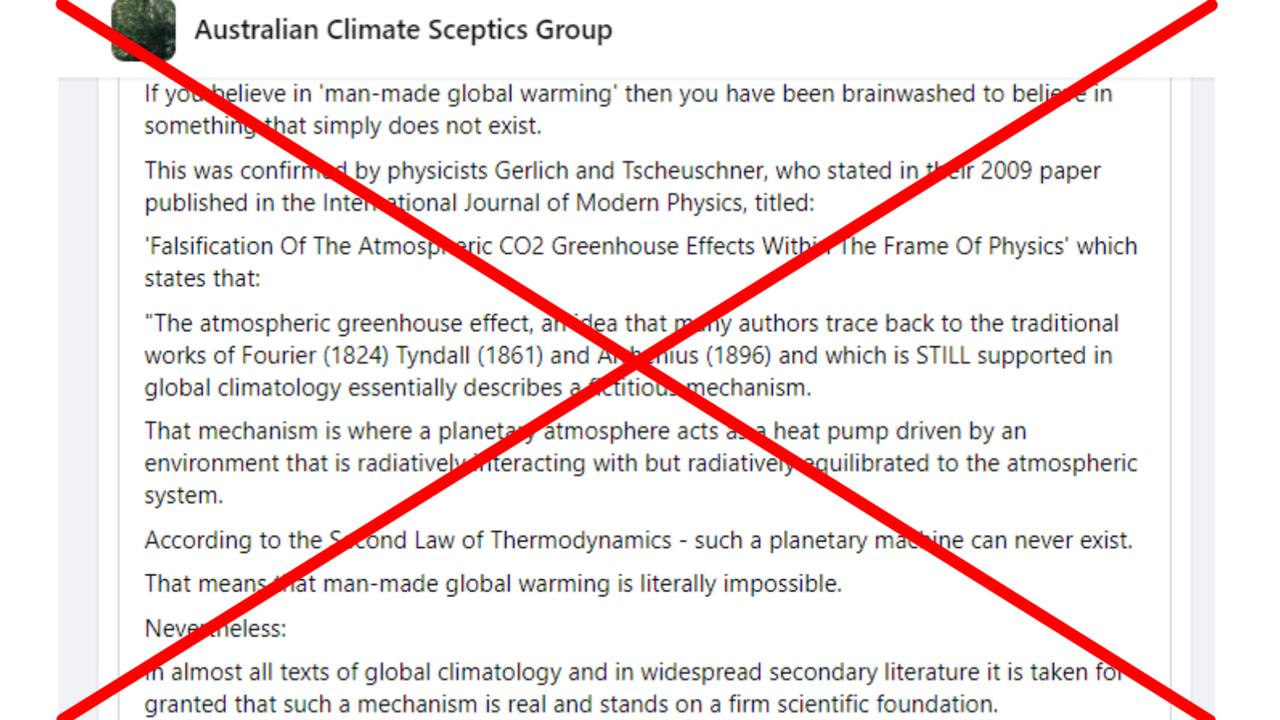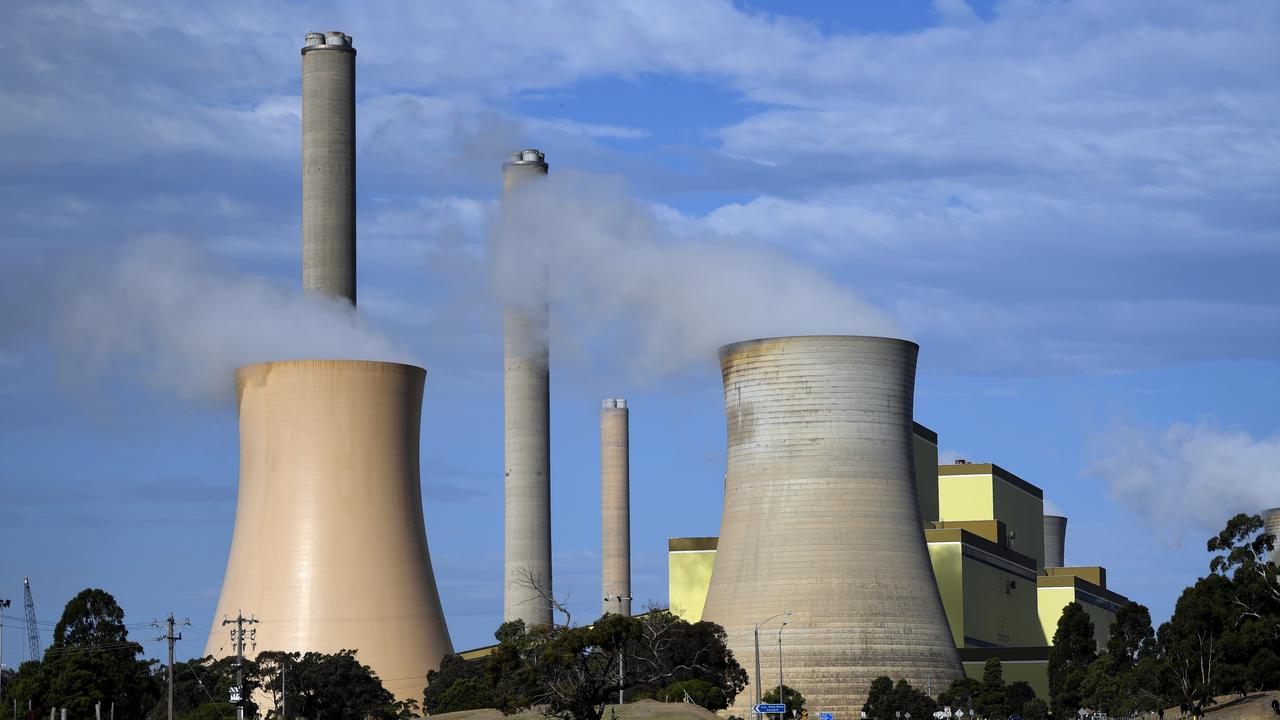WHAT WAS CLAIMED
The second law of thermodynamics shows man-made global warming is impossible.
OUR VERDICT
False. The greenhouse effect is consistent with the second law of thermodynamics.
A proliferation of social media posts are denying the existence of the greenhouse effect, claiming the second law of thermodynamics makes man-made global warming impossible.
This is false. Experts on atmospheric dynamics told AAP FactCheck the claim is nonsense and the posts misinterpret how the greenhouse effect works. Their view is supported by broad scientific consensus.
The second law of thermodynamics, formulated by mathematical physicist Rudolf Clausius in 1850, describes the relationship between thermal energy (heat) and other forms of energy, and how energy affects matter - it stipulates that heat cannot pass from a colder to a hotter body.
Global warming sceptics use the law to say that because the transfer of heat from the warmer surface of the earth to the cooler atmosphere is irreversible, global warming is impossible since the cooler atmosphere cannot heat up the warmer surface.
This argument is reflected in Facebook posts here, here, here, and here. The last of the posts, which is typical of the others, argues: "When CO2 absorbs long wave radiation, it then emits that radiation out towards cooler space, not the warmer surface."

Another post quotes a 2009 journal article by theoretical physicists Gerhard Gerlich and Ralf D. Tscheuschner in the International Journal of Modern Physics which argues the atmospheric greenhouse effect is a "fictitious mechanism", since a planetary atmosphere that acts as a heat pump can never exist, according to the second law of thermodynamics.
That post appeared on the Australian Climate Sceptics Group's Facebook page on March 21, 2023, and has been shared widely, as seen here, here, here, and here.
Martin Singh, a senior lecturer in the School of Earth, Atmosphere & Environment at Monash University, said the posts are false because they misrepresent how the greenhouse effect works - the process slows the energy being radiated to space, but doesn't stop it completely, so remains consistent with the second law of thermodynamics.
"The claim is nonsense," Dr Singh told AAP FactCheck in an email.
"The idea that the greenhouse effect violates the second law of thermodynamics crops up now and then in discussions of climate change, but it is not true.
"The claim is based on the idea that a colder body (the atmosphere) cannot heat a warmer body (the surface). But this is not how the greenhouse effect works; the greenhouse effect works by reducing the energy being radiated to space by the earth system.
"This results in an imbalance in energy which warms up the whole system (including surface and atmosphere). At all times the surface is losing heat to the atmosphere (when all forms of energy transport are taken into account), consistent with the second law of thermodynamics."

Dr Singh said there is an entire sub-field of research applying the second law of thermodynamics to climate questions.
Dr Milton Speer, a visiting fellow at the School of Mathematical and Physical Sciences at UTS, agreed the claim is false.
"There is supposed to be a balance between incoming radiation from the sun and outgoing radiation, a fact established centuries ago," he said via email. "But greenhouse gases such as CO2 trap some of the outgoing radiation which gradually heats up the oceans, atmosphere."
Dr Mehdi Seyedmahmoudian, an associate professor at Swinburne University's School of Science, Computing and Engineering Technologies, agreed that the claim misunderstands the processes involved.
"According to this law, the earth (warmer object) is transferring its heat to its surrounding open space (cooler object) via thermal radiation.
"The problem appears when the CO2 obstructs this radiation and emits this heat back to the lower atmosphere. Adding this to the fact that conduction and convection are negligible at higher altitudes, it is a no-brainer fact that the lower atmosphere remains warm while the outer layers are cold."
The Gerlich and Tscheuschner journal article has also been challenged. A comment on the article claimed their methods, logic and conclusions were in error. The original authors then published a reply to the comment.
This blog article argues the Gerlich and Tscheuschner journal article was largely responsible for the "myth that the greenhouse effect is contrary to the second law of thermodynamics".

It argues: "The Second Law does not state that the only flow of energy is from hot to cold but instead that the net sum of the energy flows will be from hot to cold. That qualifier term, 'net', is the important one here. The Earth alone is not a 'closed system', but is part of a constant, net energy flow from the Sun, to Earth and back out to space. Greenhouse gases simply inhibit part of that net flow, by returning some of the outgoing energy back towards Earth's surface".
This blog article also argues there are many errors in the original Gerlich and Tscheuschner article, and says of the second law of thermodynamics in relation to the greenhouse effect: "there is no scientific problem with radiation from a colder to a hotter body - so long as there is a higher radiation from the hotter to the colder".
The Verdict
The claim the second law of thermodynamics makes man-made global warming impossible is false.
Experts told AAP FactCheck the claim misunderstands how the greenhouse effect works, which is by reducing the energy radiated to space, resulting in an energy imbalance that warms up the earth's surface and atmosphere.
The claim is also based on a misunderstanding of the law, which allows for a transfer of heat from a cooler body to a warmer body as long as the 'net' transfer is from hot to cold.
False - the claim is inaccurate.
AAP FactCheck is an accredited member of the International Fact-Checking Network. To keep up with our latest fact checks, follow us on Facebook, Twitter and Instagram.












